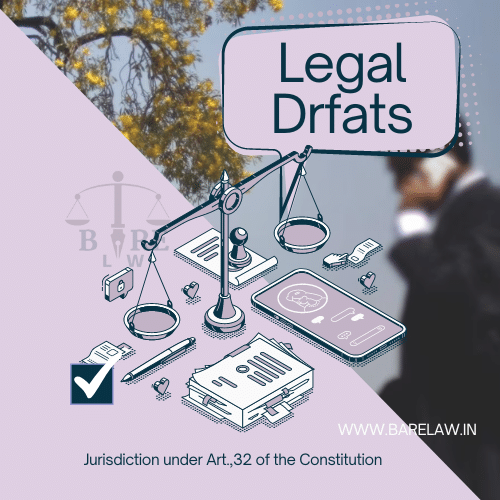
Jurisdiction under Art.,32 of the Constitution
Table of Contents
In the Supreme Court of India, New Delhi
(In exercise of jurisdiction under Art.,32 of the Constitution)
Mr. ………………………………, s/o. ………………………… village ……………….., district …………………….., at present detained at……………………. District Jail at……….
……………. Petitioner
Versus
(1) The State of ……… }
(2) The District Magistrate, ……….. and } Respondents.
(3) The Superintendent, District Jail, ……… }
Hon’ble Shri ………………….……., Chief Justice of India and his companion Justices of the Supreme Court of India.
This humble petition of the petitioner above named under Art. 32 of the Constitution of India praying for a writ of habeas corpus or such other writ, direction or order as the court may deem fit directing the respondents to cause the production of the petitioner in court and directing him to be set at liberty in accordance with law respectfully.
Sheweth:
1. That the petitioner is a respectable law-abiding citizen of India and was arrested by the ………………… [City Name] ……….…… [State] Police on the ………… day of……………. 20……. and is now confined as a detenu under the orders of the second respondent in the custody of third respondent in the District Jail at …………….
2. That the detention of the petitioner purports to be under the Preventive Detention Act, 1950.
3. That the petitioner was given the following grounds of detention under Sec. …… of the Preventive Detention Act, 1950 on the …………. day of ………. 20………
(i) On ………….……… you participated in the general meeting of the ..………. when a resolution delegating full powers to …..……… to manage the affairs of the ………..…. was passed. You also participated in an informal meeting of the …………… workers on ………., when it was decided to hold ….……. Convention on the …….………. day of …..… 20…… As a result of these meetings a resolution, sponsored by ………. has been passed by the Working Committee of the …….. on the ……… to the effect that if the …….. M. L. A’s of the ………. [State] Legislative Assembly do not voluntarily quit……., they will be compelled to do so by coercive methods.
(ii) You have in public utterances declared yourself to be a firm believer in leadership of….. and, according to you, he is the only person who could deliver goods to the…….. Community. You are of the view that in the long run…….. who were at present working as henchmen of the ….……. would also have to revert to the ……..’s lead.
(iii) Now that a resolution making the intentions of the…….. very clear has been passed that unlawful methods will be adopted, it is strongly believed that in pursuance of that resolution you will commit acts prejudicial to public order.
“Your detention has therefore been ordered to ensure the maintenance of public order.”
4. That the petitioner was advised that his arrest and detention is illegal, mala fide and capricious. One ……………… therefore moved the Hon’ble High Court of Judicature for the State of …………. at ……….[Place] on …….. in Criminal Miscellaneous Petition No. …… of ……. under Art. 226 of the Indian Constitution read with Sec. 491 of the Criminal Procedure Code praying for a writ a habeas corpus for the release of the petitioner.
5. That the said Hon’ble High Court was pleased to reject the above said petition of the petitioner herein by its judgment dated……….
6. That the petitioner is not satisfied with the orders of the Hon’ble High Court for the State of ………….. at ……….. [Place], and the petitioner is informed that the said ……..…….. is separately taking steps for obtaining leave to appeal against that order of the High Court.
7. That, in any case the petitioner is advised that his continued detention in the above circumstances is in direct violation of his fundamental rights (as herein below detailed) and therefore begs to move this Hon’ble Court under Art. 32 of the Constitution of India for a writ of habeas corpus or other appropriate writ, order or direction directing the respondents to release the petitioner forthwith on the following amongst other
Ground
(i) For that none of the grounds mentioned in para 3 above has any proximate connection or relevancy to the maintenance of public order.
(ii) For that it is an abuse of the process granted to the Executive under the Preventive Detention Act, ……… to detain the petitioner for joining in any procession or making of any speeches as alleged in sub-paragraphs (i) and (ii) of para 3 above. Such use of the Act is mala fide.
(iii) For that similarly the use of the said Act for the detention of the petitioner in respect of the alleged activities of the petitioner as mentioned in sub-paragraphs (i) and (iii) of para 3 above is mala fide.
(iv) For that the Resolution of the Working Committee dated ………… is unobjectionable…………. has been released from custody on the ground that provisions of law under which he was being prosecuted, viz., Sec. 124-A and Sec. 153-A, I.P.C., etc. have been held to be ultra vires the Constitution. The whole superstructure built by the second respondent countenanced and accepted as correct by the High Court, in its judgment referred to above falls to the grounds.
(v) For that the learned Judges of the High Court erred in taking into consideration the speech made by………. and linking the same with the Resolution of the Working Committee.
(vi) For that it is not proper to hold that any alleged past activities of the appellant not resulting in any disturbance of public order then, could from the basis of an assumption regarding the likelihood of an imminent danger of the breach of peace now, at this distance of time; nor could the passing of the Resolution of the Working Committee dated……….. bring about a change in conditions as alleged with the consequential apprehended disturbance of public tranquility. The assumption is unfounded and unreasonable. Further, the petitioner was not even a member of the said Working Committee.
(vii) For that the satisfaction of the learned District Magistrate was not based on such materials or grounds which could reasonably form the basis of an order of detention such as the one passed in this case. It is a camouflage to state that the allegations contained in the said grounds were such as were likely to be prejudicial to the maintenance of public order.
(viii) For that the detention of the petitioner is not in accordance with procedure established by law.
(ix) For that the Preventive Detention Act, …………….. is ultra vires the Constitution inter alia for the following reasons :
(a) It offends against the provisions of Art. 19(1) (a) of the Constitution in as much as it proceeds to do indirectly what it could not do directly in the matter of unjustifiably restricting the freedom of speech and expression, vide ground in sub-paragraphs (i) and (ii).
(b) It offends similarly against the provisions of Article 19(1)(b) of the Constitution inasmuch as it operates unreasonably on peaceable assembly without arms, vide ground mentioned in sub-paragraphs (ii) of para 3 above.
(c) It offends similarly against the provisions of Article 19(1) (c ) of the Constitution, vide grounds mentioned in sub-paragraphs (i) and (iii) of para 3 above.
(d) Section 3 of the said Act is contrary to procedure established by law. The subjective suggestion provided for in the section is ultra vires the Constitution.
(e) Section 7 of the said Act provides for representation to the State Government itself which is repugnant to fundamental principle of law that no man can be judge in his own cause.
(i) For that the extension dated…….. of the detention order is ultra vires and illegal. Further no grounds in respect of the extension of detention order have been supplied to the petitioner.
(ii) For that the detention order itself mentions “That security of State and the maintenance of public order,” the grounds supplied relate only to the maintenance of public order. The said detention order is in itself either vague and inoperative or illegal.
(iii) For that that decision in ……………….. case does not form appropriate precedent in this matter as it was given in a different factual context. For the same reason ……………….. case is not so binding and further the purpose therein was different and the Constitution did not operate thereon.
(iv) For that the decision in ……………….. case loses much of its validity and operation as precedent as there were competing reasons given by different judges which almost neutralize each other leaving the field clear.
(v) For that in ………………..case reference was made to “due process of law” the Draft Committee’s Report, the Debates, etc. Such matters could not be referred to. Personal liberty has always been understood to include freedom of speech and right of association and peaceable assembly. Constitutions are interpreted in a manner in many respects peculiar to themselves. The correct approach to the problem of interpreting Articles 19 to 21 of the Constitution has been entirely overlooked. The well-known rules of interpretation have been ignored in this behalf. Even in matters of procedure the various fundamental principles which form now the basis of legislation in this behalf for generations past are easily ascertainable and have been declared by the Judge in India and in the Privy Council and are now well established. To say that any enactment of Parliament forms the procedure established by law is contrary to the Constitution and is not good law.
8. Your humble petitioner therefore begs to pray that Your Lordships may be pleased to issue rule nisi to the respondents directing them to produce the petitioner before this Hon’ble Court and to justify his detention in accordance with procedure established by law and that after hearing the parties, Your Lordships may be pleased to issue a writ of habeas corpus or other appropriate writ or direction to set the petitioner at liberty. For which favour this humble petitioner shall ever pray.
Delhi…………..
(Sd.)
Advocate,
Dated …………..
Settled by Supreme Court.
Senior Advocate, Supreme Court.
Barelaw, an online platform dedicated to delivering comprehensive legal knowledge, proudly presents its exclusive category of case briefs. This section is meticulously crafted to offer insightful analyses of landmark judgments, providing a valuable resource for legal professionals, students, and anyone interested in understanding the intricacies of law. Our case briefs delve deep into pivotal court decisions, exploring the rationale behind each judgment and its impact on the legal landscape.
We understand that navigating the complexities of legal judgments can be challenging. That’s why our case briefs are designed to be both informative and accessible, ensuring that readers gain a clear understanding of the key legal principles involved. Each brief includes a summary of the facts, the legal issue at hand, the court’s reasoning, and the ultimate decision. This structured approach makes it easier for our audience to grasp the nuances of each case.
Our website is a treasure trove of legal wisdom, constantly updated with the latest and most significant cases. Whether you’re a law student seeking to enhance your knowledge, a practicing attorney looking for a quick reference, or simply a curious mind eager to understand the law’s evolution, Barelaw is your go-to destination.
Explore our case briefs and immerse yourself in the world of law. Visit our website now and discover the wealth of legal knowledge at your fingertips. The link is provided below for your convenience and direct access to our expansive legal database





